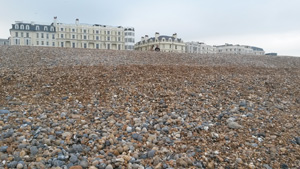Robert Nemeth on Brighton Foreshore
Dr Richard Russell transformed Brighton by famously promoting the health benefits of seawater. His own home, Russell House, was conveniently built right by the sea in 1753. Images of Brighton seafront from the mid-1700s show the house on the edge of a cliff, just above the water.

The Royal Albion Hotel was built on the site in 1826 to the designs of prolific local architect Amon Henry Wilds after Russell House was demolished in 1823. Yet we all know that the Royal Albion is separated from the sea by a wide road and broad pavements. And a generous colonnade and ramps. And the shingle of the beach itself.
It is not the case that poetic licence has been shown by artists of olde. The topography of the town has in fact changed. The Brighton of today does still sit on the top of a 40ft-high cliff but this cliff is now hidden away from view. In effect, the beach has grown upwards whilst the land has extended outwards.
“Images from the mid-1700s show the house on the edge of a cliff, just above the water”
The first wooden groynes were built in Brighton in 1723-4 but these were insubstantial. The first concrete groyne was constructed at the bottom of East Street in 1876 and the second, the Albion Groyne (originally called the Aquarium Promenade Groyne), was added in 1876. These led to the build-up of the shingle beach. King’s Road was built in 1821-2 to replace a cliff-top track. Its construction was actually supervised by Amon Henry Wilds. The various stages of the road’s construction can easily be seen today in the brickwork within some of Brighton’s many seafront arches. It was widened during the 1850s and 1860s. When it was widened again during the 1880s, the extensive works included the construction of the huge shelter beneath the promenade at the bottom of West Street which was, until recently, Riptide Gym. Land was essentially being claimed from the sea.

Looking further back, the opposite happened. The Brighton of 1086, as recorded in the Domesday Book, is thought to have existed below the cliff but this so-called ‘Lower Town’ was shrinking. 40 acres are said to have been lost to the sea from 1290 to 1340. The Lower Town was burnt by the French in 1514 and then finished off by the great storms of 1703 and 1705.
It is not surprising that Brighton’s fishermen thought that a move to the cliff-top would be a far safer bet.
www.buildingopinions.com
robert@buildingopinions.com




















